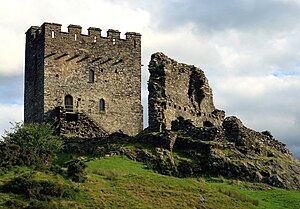| Dolwyddelan Castle | |
|---|---|
Castell Dolwyddelan (Welsh) | |
| Dolwyddelan, Conwy County Borough, Wales | |
 The castle from the north | |
| Coordinates | 53°03′11″N 03°54′30″W / 53.05306°N 3.90833°W |
| Site information | |
| Controlled by | Cadw |
| Condition | Partially ruinous |
| Website | Castell Dolwyddelan |
| Site history | |
| Built | c. 1210 – c. 1240 |
| Built by | Llywelyn ab Iorwerth |
| In use | c. 1210 – after 1488 |
| Materials | Local grit and slate rubble |
| Battles/wars | Conquest of Wales by Edward I |
| Official name | Castell Dolwyddelan |
| Reference no. | CN040[1] |
Listed Building – Grade I | |
| Official name | Dolwyddelan Castle |
| Designated | 17 February 1997 |
| Reference no. | 18253[2] |
Dolwyddelan Castle (/dɒlwɪðˈɛlæn/ dol-with-EL-an; Welsh: Castell Dolwyddelan; Welsh pronunciation: [kastɛɬ dɔlwɪð’ɛlan]) is a thirteenth-century castle located west of Dolwyddelan in Conwy County Borough, Wales. Tomen Castell, a late twelfth-century tower, is located south-east of the castle.
Dolwyddelan Castle was probably begun by Llywelyn ab Iorwerth, the ruler of the Kingdom of Gwynedd, between 1210 and 1240 to defend an east–west route within the kingdom. It superseded Tomen Castell, a small tower possibly built by Llywelyn's father, Iorwerth Drwyndwn. Dolwyddelan was captured by Edward I of England in 1283, and despite being immediately refortified its military significance subsequently declined. In 1488 Maredudd ab Ieuan, a member of a family from neighbouring Eifionydd, purchased the lease and repaired the structure, but it was ruinous by the mid-nineteenth century. Between 1848 and 1850 the keep was restored and reconstructed by Peter Drummond-Burrell, 22nd Baron Willoughby de Eresby, and in 1930 the castle was placed in state care; it is currently managed by Cadw, the Welsh Government's historic environment service, and open to the public. It was designated a grade I listed building in 1997 and is a scheduled monument.
The castle is built on a small knoll and consists of a keep on the east side and a tower on the west, linked by walls to form a roughly circular enclosure. The building history is uncertain, but the keep is the oldest structure. It has been heightened twice, first by either Edward I or Maredudd ab Ieuan and second during the nineteenth-century restoration. The western tower may have been constructed in the late thirteenth century by Llywelyn ap Gruffudd or shortly after the English capture of the castle.
